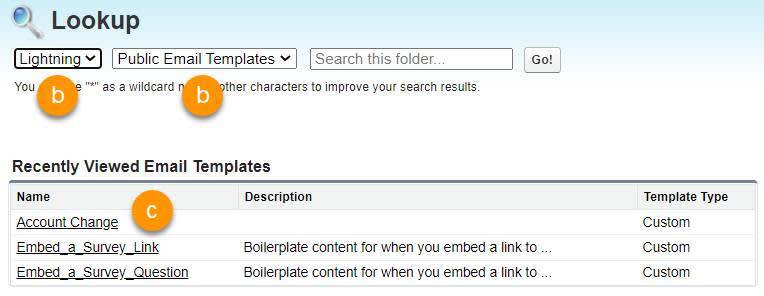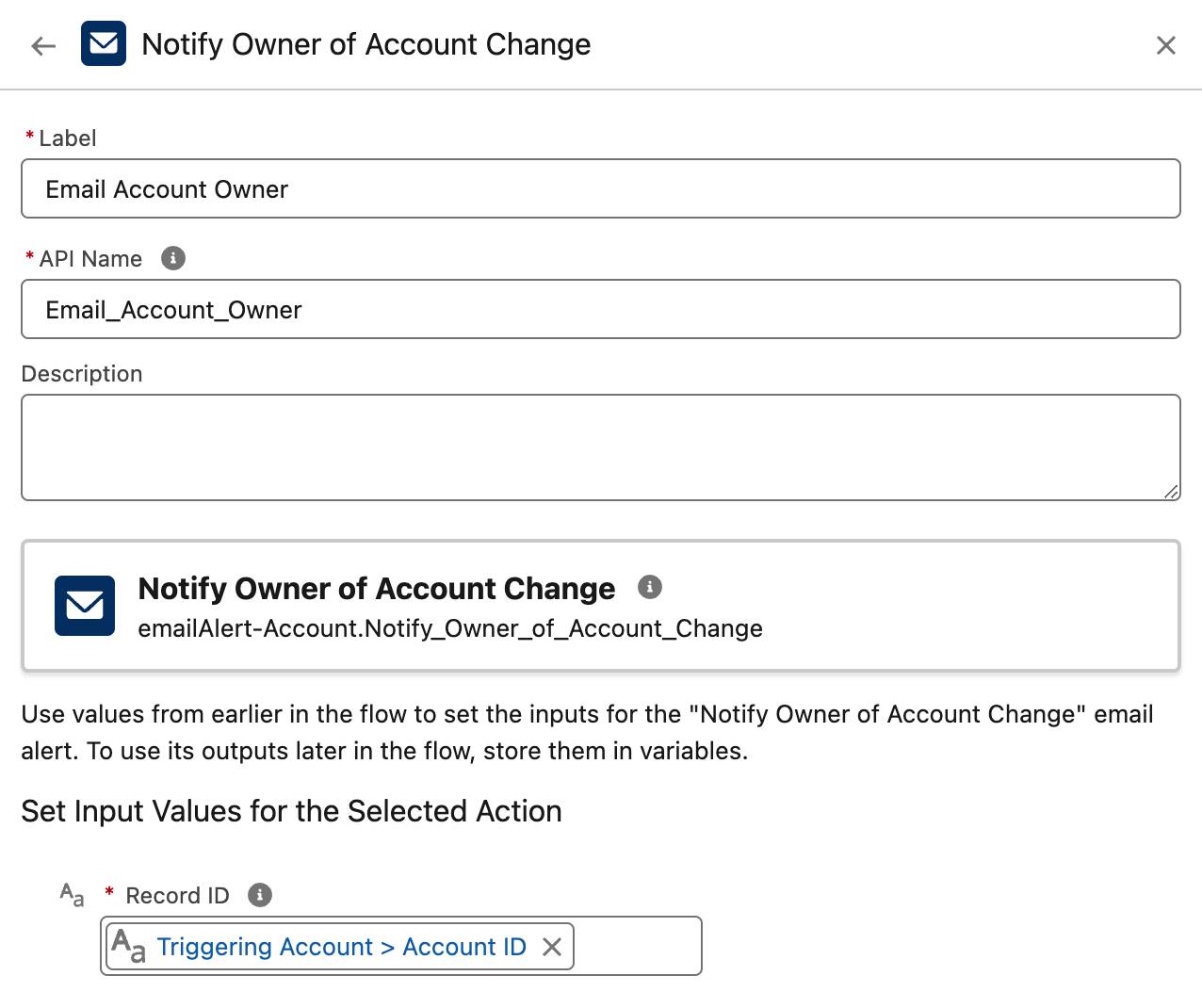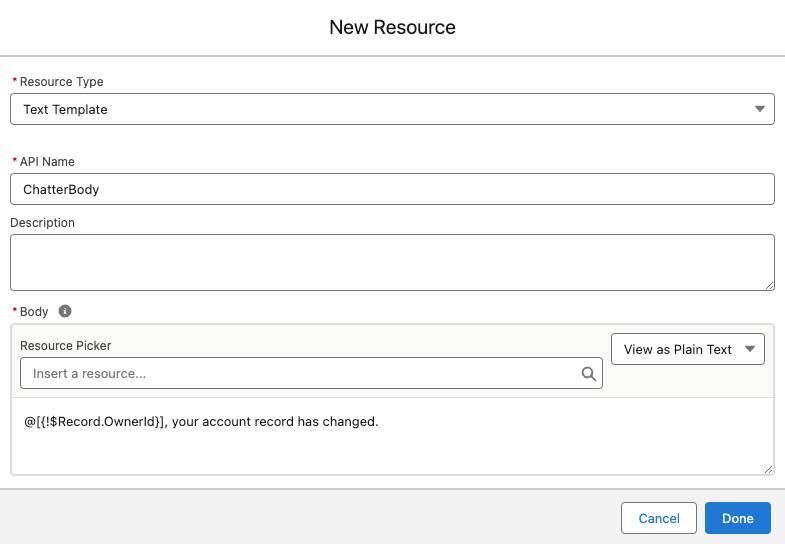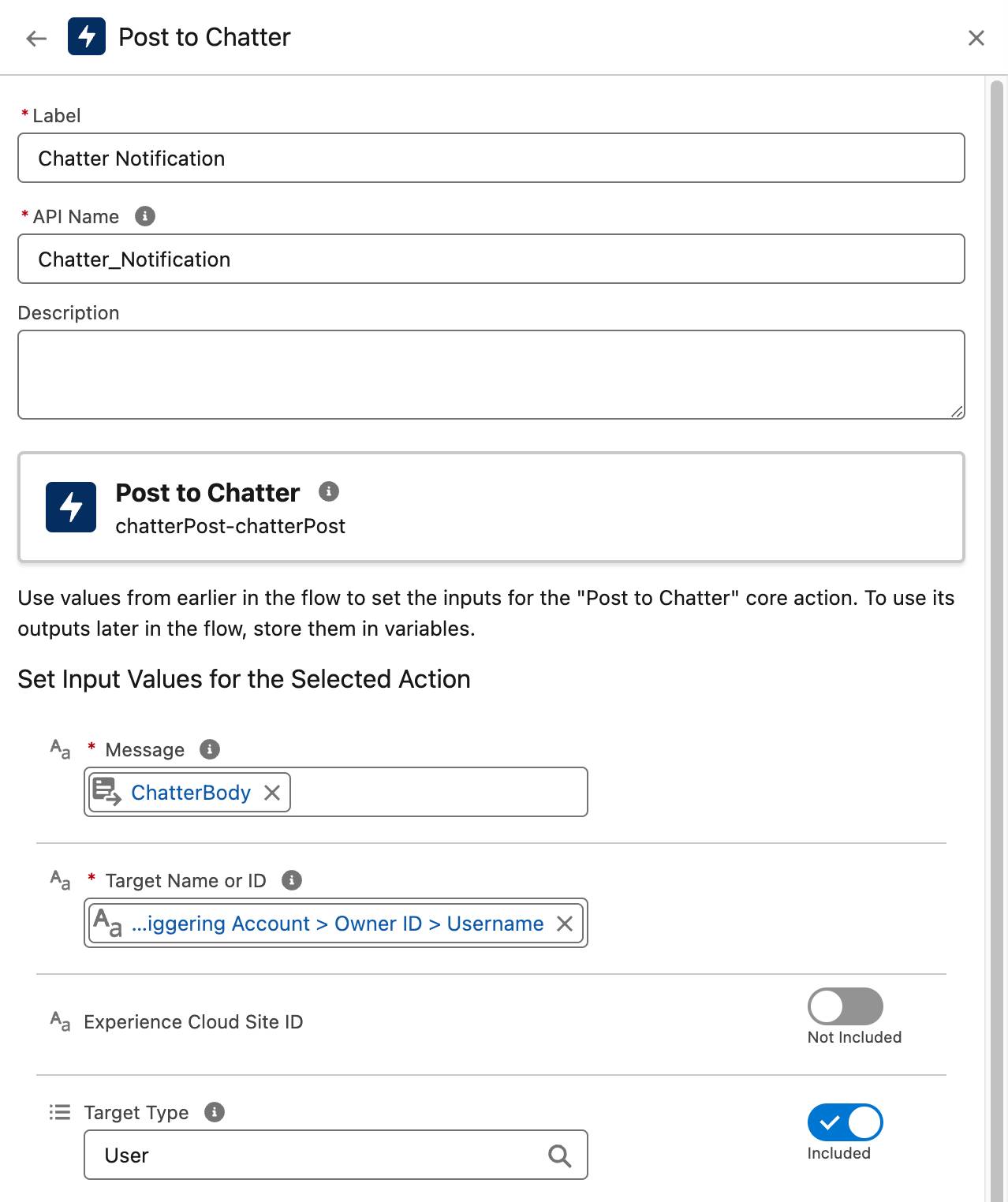Comunicarse con el elemento de acción
Objetivos de aprendizaje
Después de completar esta unidad, podrá:
- Crear un flujo que envíe un email.
- Usar plantillas de texto para redactar mensajes con formato que pueda usar Flow Builder.
- Crear un flujo que cree una publicación de Chatter.
- Crear un flujo que envíe un registro para su aprobación.
Es algo fantástico poder usar flujos para crear, actualizar y eliminar registros, pero no siempre es bueno hacer esas tareas de forma silenciosa. Los flujos también pueden hacer lo siguiente:
- Informar a uno o más usuarios de un cambio.
- Ayudar a los usuarios a enviar una notificación a un cliente.
- Permitir que los usuarios soliciten la aprobación de un cambio antes de confirmarlo.
Estas son todas formas de comunicación que puede automatizar con Flow Builder, lo que garantiza que los usuarios y clientes tengan la información que necesitan.
Presentación del elemento de acción
Para que toda esta comunicación maravillosa sea posible, se usa el elemento de acción. A pesar de su nombre básico, este elemento tiene una riqueza de superpoderes, ¡como un héroe de acción real!

El elemento de acción puede comunicarse con usuarios, clientes y sistemas externos. También puede realizar algunas tareas de automatización avanzadas, pero en este módulo nos enfocamos en comunicarnos con las personas.
Enviar un email con una alerta de email
El departamento de ventas de Pyroclastic desea que el propietario de cuenta reciba una notificación inmediata cuando cambien los detalles clave de una cuenta. Flo le pide que cree un flujo mediante el cual se envíe un email al propietario de cuenta cuando ocurra un cambio.
Hay varias maneras de enviar un email en un flujo, pero recomendamos usar el elemento de acción para seleccionar una acción de flujo de trabajo de alerta de email. Este método tiene la mayoría de las funciones y es fácil de configurar si tiene alertas por email existentes de reglas de flujo de trabajo.
Si todavía no tiene la alerta de email que necesita, créela primero.
Crear una alerta de email
- Desde la ficha Activity (Actividad) en un registro de cuenta, haga clic en
 para crear un email.
para crear un email.
- Subject (Asunto):
Account change notice(Aviso de cambio de cuenta) - Body (Cuerpo):
Your account record has changed.(Cambió su registro de cuenta). Si lo desea, puede agregar un texto más elaborado o combinar campos a elección.
- Related To (Relacionado con): verifique que haya una cuenta seleccionada.
- Haga clic en
 y seleccione Save as new template (Guardar como plantilla nueva).
y seleccione Save as new template (Guardar como plantilla nueva).
- Template Name (Nombre de plantilla):
Account Change(Cambio de cuenta) - Folder (Carpeta): Public Email Templates (Plantillas de email públicas)
- En Setup (Configuración), introduzca
Email Alerts(Alertas por email) en el cuadro de búsqueda rápida y haga clic en Email Alerts (Alertas por email).
- Haga clic en New Email Alert (Nueva alerta de email).

- En Description (Descripción), introduzca
Notify Owner of Account Change(Notificar sobre cambio a propietario de cuenta).
Las descripciones deben ser, valga la redundancia, descriptivas, ya que es la manera de encontrar la alerta de email que busca en una larga lista de acciones.
- En Unique Name (Nombre exclusivo), mantenga el valor predeterminado:
Notify_Owner_of_Account_Change.
- En Object (Objeto), seleccione Account (Cuenta).
Cada alerta de email está vinculada a un objeto específico, porque el objeto define los posibles destinatarios. Por ejemplo, debido a que esta alerta de email está relacionada con el objeto de cuenta, tiene acceso a destinatarios específicos de la cuenta, como los miembros del equipo de cuenta.
- Seleccione una plantilla de email para usar:
- Haga clic en la lupa (
 ) junto al campo Email Template (Plantilla de email).
) junto al campo Email Template (Plantilla de email).
- En la ventana de búsqueda, seleccione Lightning y Public Email Templates (Plantillas de email públicas).
- Haga clic en la plantilla de email Account Change (Cambio de cuenta).

- En Recipient Type (Tipo de destinatario), seleccione Owner (Propietario).
- En Recipients (Destinatarios), mueva Account Owner (Propietario de cuenta) de la lista Available Recipients (Destinatarios disponibles) a la lista Selected Recipients (Destinatarios seleccionados).

- Haga clic en Save (Guardar).
Crear un flujo que use la nueva alerta de email para enviar un email
Su alerta de email ya está lista para usar. Para crear un flujo que envíe el email, siga estos pasos.
- Cree un flujo desencadenado por registro:
- Object (Objeto): Account (Cuenta)
- Trigger the Flow When (Active el flujo cuando): A record is updated (Se actualiza un registro)
- Condition Requirements (Requisitos de condición): Any Condition Is Met (OR) (Se cumple cualquier condición [OR])
- En la sección Filter Records (Filtrar registros), defina las condiciones que indican al elemento qué registros debe recuperar.
- Primera condición:
- Field (Campo): Número de la cuenta
- Operator (Operador): Is Changed (Se cambia)
- Value (Valor): Verdadero
- Field (Campo): Número de la cuenta
- Segunda condición:
- Field (Campo): Ingresos anuales
- Operator (Operador): Is Changed (Se cambia)
- Value (Valor): Verdadero
- Field (Campo): Ingresos anuales
- Tercera condición:
- Field (Campo): Nombre de la cuenta
- Operator (Operador): Is Changed (Se cambia)
- Value (Valor): Verdadero
- Field (Campo): Nombre de la cuenta
- Cuarta condición:
- Field (Campo): Valoración de cuenta
- Operator (Operador): Is Changed (Se cambia)
- Value (Valor): Verdadero
- Field (Campo): Valoración de cuenta
- Primera condición:
- En el lienzo del flujo, en la ruta posterior al elemento Start (Inicio), haga clic en
 . Seleccione Action (Acción).
. Seleccione Action (Acción).
(Cuando está en un flujo desencadenado por registro, en su lugar, puede hacer clic en Send Email Alert [Enviar alerta de email]. Por lo tanto, las únicas acciones disponibles son las alertas de email).
- En la barra de búsqueda, escriba
emailAlertpara mostrar una lista de alertas de email disponibles y, luego, seleccione Notify Owner of Account Change (Notificar sobre cambio a propietario de cuenta).
- En Label (Etiqueta), introduzca
Email Account Owner(Propietario de cuenta de email).
- En Record ID (Id. de registro), seleccione Triggering Account (Cuenta desencadenante) > Account ID (Id. de cuenta).

- Guarde el flujo. En Flow Label (Etiqueta de flujo), introduzca
Send Email on Account Change(Enviar email cuando cambie la cuenta).
¡Aquí lo tiene! El flujo ahora procesa el email de manera eficiente.
Publicar en Chatter
Si enviar un email no es su estilo y prefiere enviar un mensaje en Salesforce, puede usar el elemento de acción para crear una publicación de Chatter. Puede publicar en un registro, un grupo de Chatter, las noticias en tiempo real de un usuario o cualquier otro lugar que tenga noticias en tiempo real de Chatter. Pero primero, necesita dos elementos:
- Una plantilla de texto que contiene lo que desea publicar
- Un recurso que contiene la Id. del lugar donde desea publicar
Debido a que este flujo hará lo mismo que el flujo Send Email on Account Change (Enviar email cuando cambie la cuenta), modificaremos dicho flujo y lo guardaremos como un flujo nuevo.
La plantilla de texto, su amiga en la comunicación
Como no puede escribir un mensaje largo y con formato directamente en el elemento de acción, necesita algo más para almacenar ese mensaje. Ahí es cuando la plantilla de texto se vuelve su amiga en la comunicación.
En Flow Builder, las plantillas de texto son recursos que pueden contener un fragmento de texto. El texto puede ser una palabra, una oración o muchos párrafos, y puede contener campos de combinación.
Crear una plantilla de texto
- En el flujo Send Email on Account Change (Enviar email cuando cambie la cuenta), si la caja de herramientas aún no está abierta, haga clic en
 para abrirla.
para abrirla.
- Haga clic en New Resource (Nuevo recurso).
- En Resource Type (Tipo de recurso), seleccione Text Template (Plantilla de texto).
- En API Name (Nombre de API), introduzca
ChatterBody.
- Junto al campo Resource Picker (Selector de recursos), cambie View as Rich Text (Ver como texto enriquecido) a View as Plain Text (Ver como texto sin formato).
- En el campo Resource Picker (Selector de recursos), seleccione Triggering Account (Cuenta desencadenante) >Owner ID (Id. de propietario) (la que no tiene > en la línea).
Al principio del cuerpo del mensaje, se inserta un campo de combinación para el nombre del propietario.
- Agregue corchetes [ ] alrededor del campo de combinación, por ejemplo:
[{!$Record.OwnerId}] - Agregue el símbolo @ al principio, por ejemplo:
@[{!$Record.OwnerId}]
Cuando está seguido por un valor encerrado entre corchetes, el símbolo @ inserta el valor como una mención en la publicación de Chatter.
- Después del corchete de cierre, introduzca
, your account record has changed.(cambió su registro de cuenta).
- Haga clic en Done (Listo).
- En la barra de botones, haga clic en
 junto al botón Save As New Version (Guardar como nueva versión) y seleccione Save As New Flow (Guardar como nuevo flujo). Esta opción evita la sustitución de la función Send Email (Enviar email) en el flujo Account Change (Cambio de cuenta).
junto al botón Save As New Version (Guardar como nueva versión) y seleccione Save As New Flow (Guardar como nuevo flujo). Esta opción evita la sustitución de la función Send Email (Enviar email) en el flujo Account Change (Cambio de cuenta).
- En Flow Label (Etiqueta de flujo), introduzca
Post to Chatter on Account Change(Publicar en Chatter cuando cambie la cuenta).
- Haga clic en Save (Guardar).
La próxima plantilla de texto ahora se puede mencionar en cualquier campo de Flow Builder donde puede seleccionar un recurso de texto.
Crear un elemento que utilice la plantilla de texto nueva para publicar en Chatter
- Si el flujo Post to Chatter on Account Change (Publicar en Chatter cuando cambie la cuenta) no está abierto aún, ábralo ahora.
- En el lienzo del flujo, pase el cursor sobre el elemento Email Account Owner (Propietario de cuenta de email) y haga clic en
 .
.
- Seleccione Delete Element (Eliminar elemento).
- En el lienzo de flujo, haga clic en
 . Seleccione Action (Acción).
. Seleccione Action (Acción).
- En la barra de búsqueda, introduzca
post(publicar) y seleccione Post to Chatter (Publicar en Chatter).
- En Label (Etiqueta), introduzca
Chatter Notification(Notificación de Chatter).
- En Message (Mensaje), seleccione la plantilla de texto ChatterBody.
- En Target Name or ID (Id. o nombre de destino), seleccione Triggering Account (Cuenta desencadenante) >Owner ID (Id. de propietario) (la que tiene > en la línea) > Username (Nombre de usuario).
- Habilite Target Type (Tipo de destino) para incluir el campo Target Type en este elemento de acción.
- En Target Type (Tipo de destino), introduzca
User(Usuario).
Debido a que el destino que especificó es un usuario, debe introducirUser(Usuario) como el tipo de destino, aunque no aparezca como una opción sugerida. Si el destino fuera un grupo de Chatter, introduciríaGroup(Grupo). Cuando el destino es un registro, puede dejar el campo Target Type (Tipo de destino) deshabilitado.
- Guarde el flujo.
¡Listo! El flujo ahora funciona con Chatter sin problemas.
Enviar un registro para su aprobación
Los equipos de ventas de Pyroclastic dependen de los procesos de aprobación para solicitar la autorización de la gestión de los descuentos de oportunidad. Sin embargo, Flo se entera por rumores que el personal de ventas a veces se olvida de hacer clic en el botón de enviar para aprobación cuando está lista una negociación. ¿No sería fantástico si la oportunidad se enviara automáticamente para aprobación al llegar a una etapa determinada? Puede ser, ¡con los flujos!
Adivine: ¿qué elemento se utiliza para enviar solicitudes de aprobación?
Correcto, el elemento de acción. Antes de crear una acción para enviar solicitudes de aprobación, necesita lo siguiente:
- Un proceso de aprobación activo
- Una variable u otro recurso que contenga la Id. del registro que se aprobará
- Opcional:
- Una plantilla de texto con el texto que se enviará al aprobador
- Una variable u otro recurso que contenga la Id. del remitente
Siga estos pasos para crear un flujo que envíe un registro para su aprobación.
- Cree un flujo desencadenado por registro:
- Object (Objeto): Opportunity (Oportunidad)
- Trigger the Flow When (Active el flujo cuando): A record is created or updated (Se crea o se actualiza un registro)
- Condition Requirements (Requisitos de condición): All Conditions Are Met (AND) (Se cumplen todas las condiciones [AND])
- Field (Campo): Etapa
- Operator (Operador): Equals (Es igual a)
- Value (Valor): Proposal/Price Quote (Propuesta/Presupuesto)
- When to Run the Flow for Updated Records (Cuándo ejecutar el flujo para los registros actualizados): Only when a record is updated to meet the condition requirements (Solo cuando un registro se actualiza para cumplir los requisitos de condición)
- Optimize the Flow for (Optimice el flujo para): Actions and Related Records (Acciones y registros relacionados).
- En el lienzo del flujo, en la ruta posterior al elemento Start (Inicio), haga clic en
 . Seleccione Action (Acción).
. Seleccione Action (Acción).
- En la barra de búsqueda, escriba
submit(enviar) y seleccione Submit for Approval (Enviar para aprobación).
- En Label (Etiqueta), introduzca
Request Opp Approval(Solicitar aprobación de oportunidad).
- En Record ID (Id. de registro), seleccione Triggering Opportunity (Oportunidad desencadenante) > Opportunity ID (Id. de oportunidad).
- Habilite la opción Approval Process Name or ID (Nombre o Id. de proceso de aprobación) y escriba
PriceQuoteApproval.
Si deja este campo en blanco, el flujo sigue el método normal para determinar qué proceso de aprobación ejecutar: el primer proceso de aprobación activo del objeto actual cuyos criterios de entrada se cumplan.
- Habilite la opción Submitter ID (Id. del remitente) e introduzca Triggering Opportunity (Oportunidad desencadenante) > Owner ID (Id. de propietario).
Utilice la Id. del remitente cuando desee que el remitente no sea el usuario que ejecutó el flujo. Si el remitente no es un usuario permitido para el proceso de aprobación, o bien si el proceso de aprobación seleccionado tiene criterios de entrada que no se cumplen, el flujo genera errores.
- Guarde el flujo. En Flow Label (Etiqueta de flujo), introduzca
Price Quote Approval(Aprobación de presupuesto).
¡Felicitaciones! El flujo ahora funciona sin problemas en varias formas de comunicación. En la siguiente unidad, aprenderemos otra forma de recuperar datos que pueden ayudar con el proceso de comunicación del flujo.
Recursos
- Documentación: Crear una plantilla de email en Lightning Experience
- Documentación: Plantillas de email en Salesforce Classic
- Documentación: Envío de emails en un flujo
- Trailhead: Administración de Chatter para Lightning Experience
- Trailhead: Construir un proceso de aprobación de descuento
